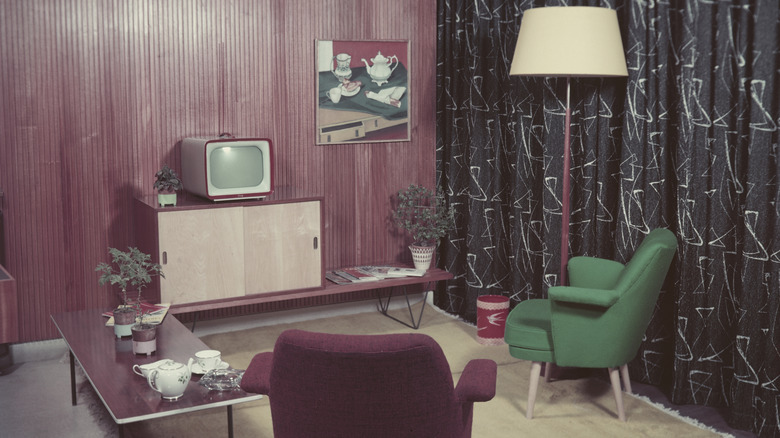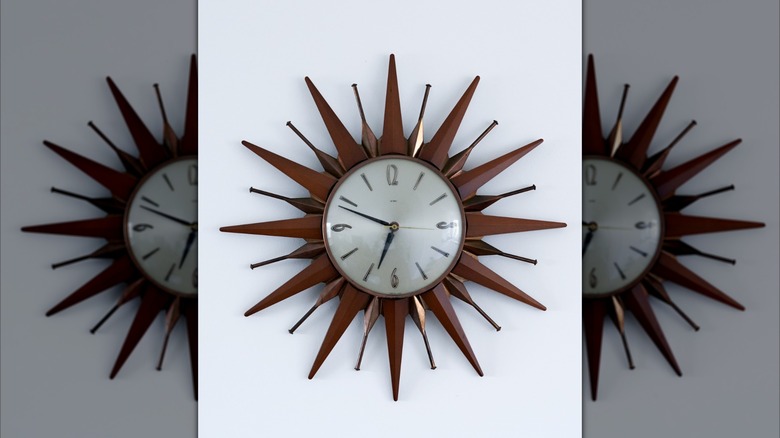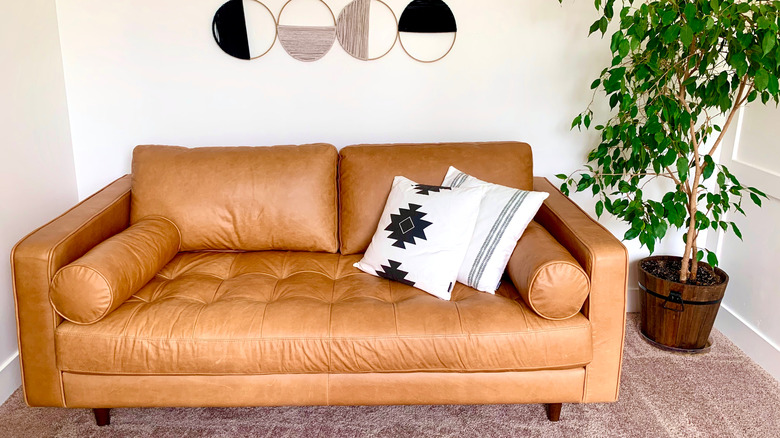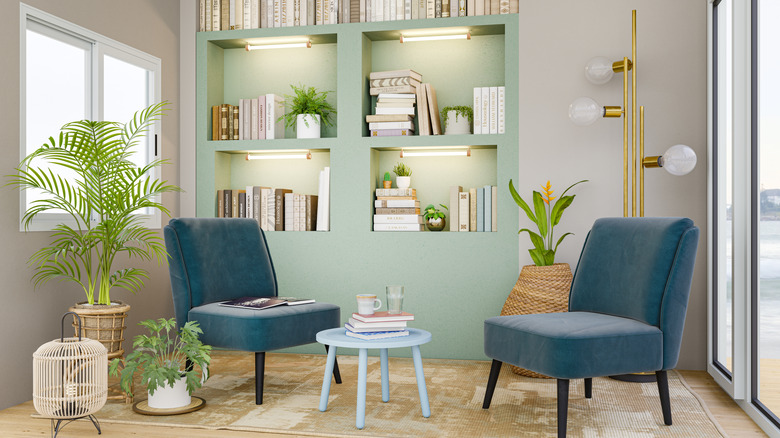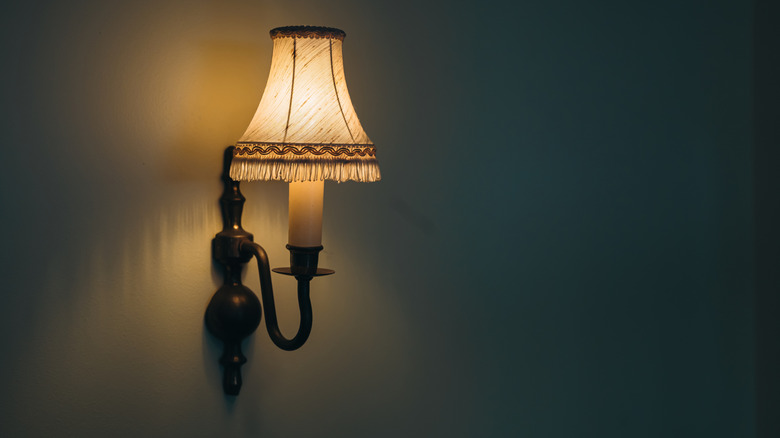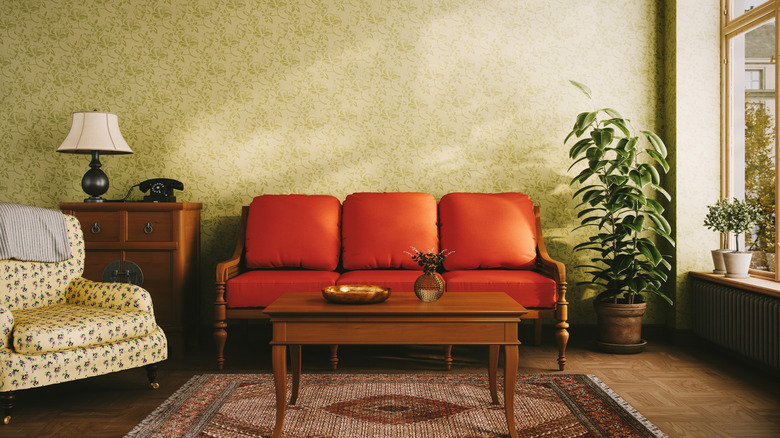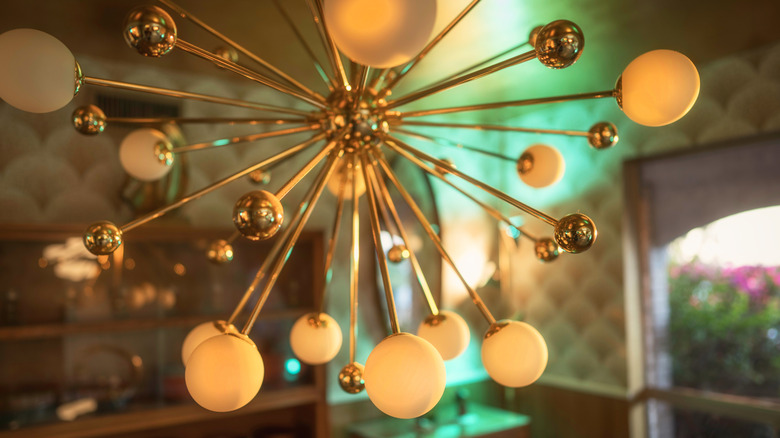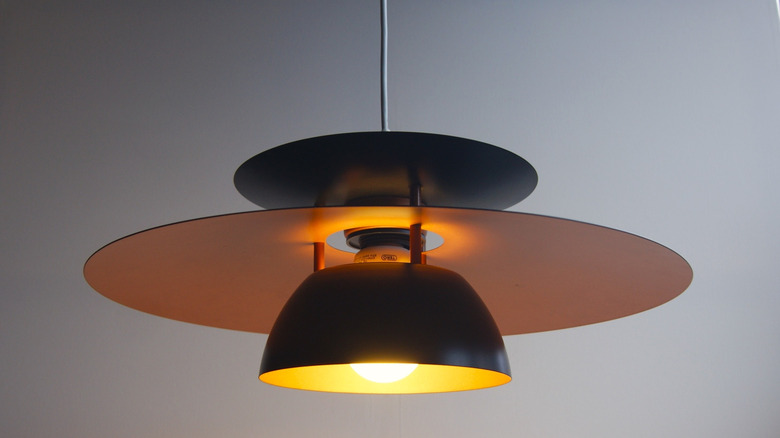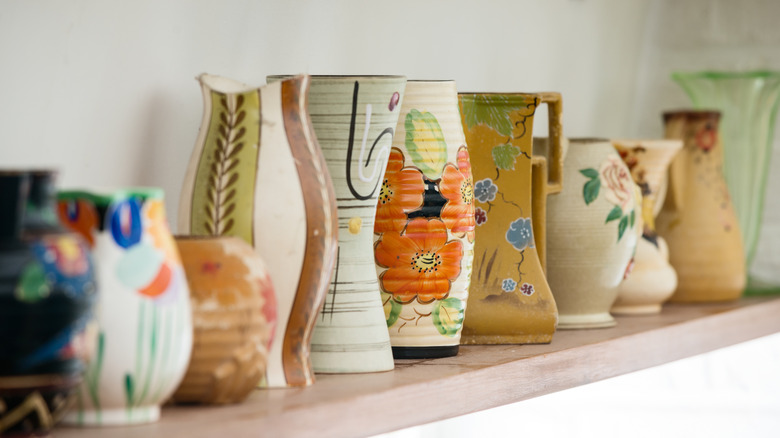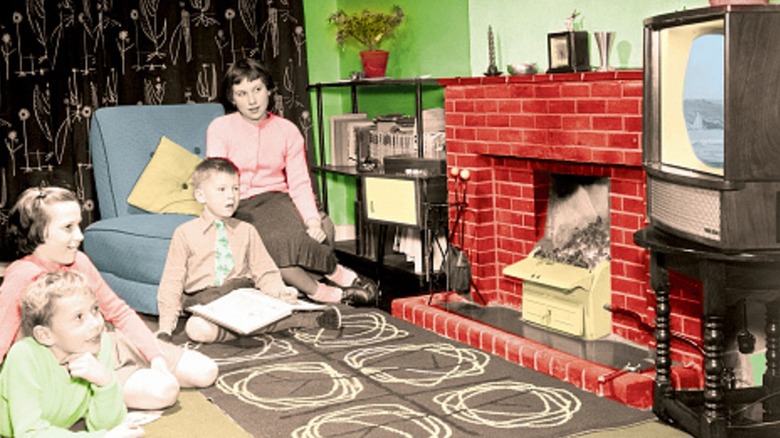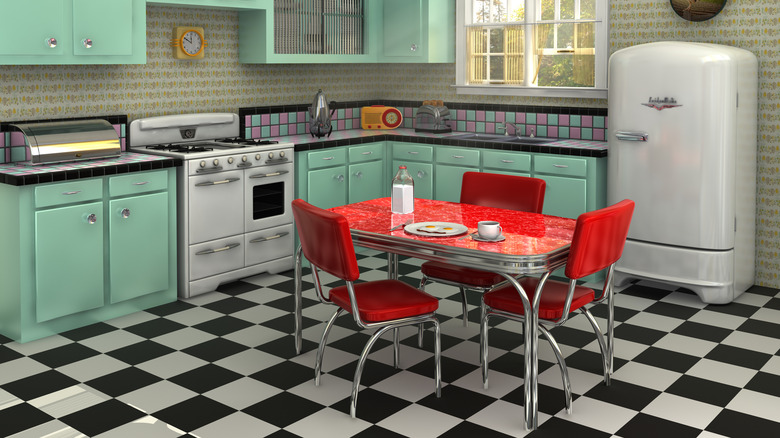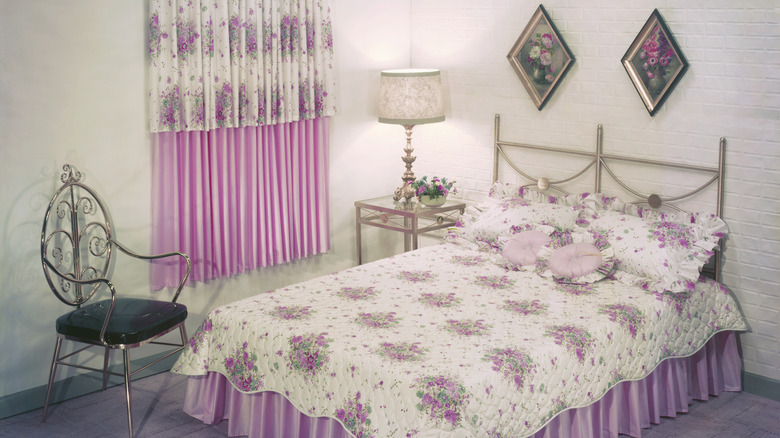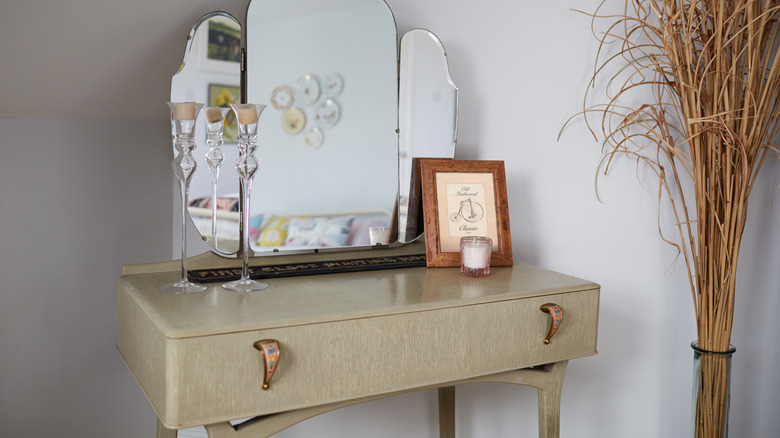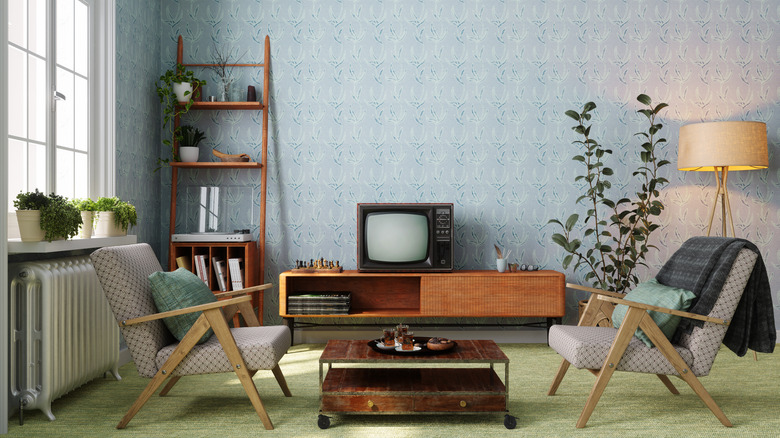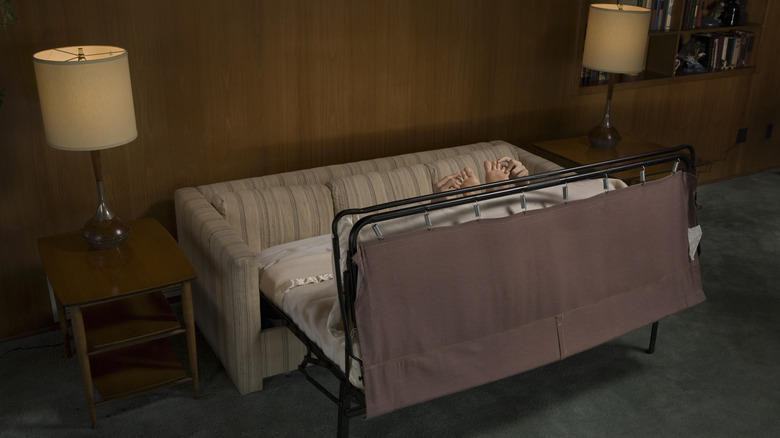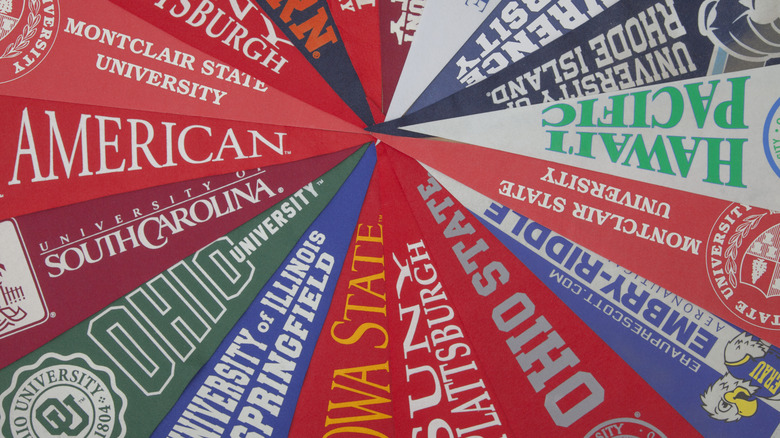The Old-School Decor People Loved Having In Their Home In The '50s
We may receive a commission on purchases made from links.
Homes of the 1950s had a sense of art and color. While many furniture pieces were sleek, often inspired by Scandinavian design, the walls were adorned with intricate designs, ranging from sunburst clocks to abstract, patterned wallpaper and art. Kitchens and bathrooms were decorated with coral, seafoam, and other pastel colors that brought brightness and joy to the rooms. (Here are some more colors that would have been seen in 1950s homes.) Mid-century modern became the classic popular style during this decade. By the 1950s, most homes had TV sets, so they needed living room spaces that allowed them to watch the television, which meant TV stands would become a popular item.
The wall decor was futuristic, for the time, too. Yet, people still held onto their old values of ensuring the space was neat and organized, with low-profile couches and built-in shelving. When the couches weren't low to the ground, they had sleek, slender legs, as did the TV stands and coffee tables. Children's rooms were adorned with posters and pennants, while living rooms went with simpler decor, including sconce lighting in the bathrooms and bedrooms. Living rooms became a friendly space for the family to spend time and an extra room for guests by adding sofa beds. It was a time for change, now that the war had passed, and interior design was showing that families were once again beginning to prosper.
To truly appreciate the style of 1950s homes, let's take a closer look at the individual pieces and design touches that brought this era to life.
Sunburst clocks adorned walls
The first sunburst clock was created in 1949, so it's no surprise that homes from the 1950s found their walls adorned with this stylish accent. The clock's design added a futuristic look, a trend that was becoming increasingly popular in homes at the time. Atomic Age design emerged in the 1940s and continued to flourish into the 1960s. The sunburst clock was only one small part of this fad, and you can still often spot them in antique stores. It added a little something extra to the walls, which fit well with abstract art and kitschy (by today's standards) wallpaper designs that a basic round clock couldn't match.
Low profile couches were a sleek addition
Low-profile couches were the way to go in the 1950s. A lot of this was because people were looking for more sleek design elements, so something with slender legs that didn't have a bulky frame gave that look of refinement. The legs were often shorter (hence the low profile) or tapered, matching the legs on TV stands and coffee tables. The edges were smooth, though some still played with the look of the bulkier couches that came before them. Walk into any antique shop and this is the mid-century couch design you're most likely to see.
Built-in shelving gave rooms more space
Another element that added to the refined and sleek look of homes in the 1950s was the built-in shelving spaces. These left room for the new television and the stand to hold it. It also helped make space when guests stayed over on the convertible couch. It was one more place to decorate with your favorite books, ceramic vases, and any other collectibles of the time. Some built-in shelving was more unique than others, such as shelves open on both sides that were part of a room-dividing partition. However, even modern-day designers suggest built-ins for smaller rooms.
Sconce lights lit bathrooms and bedrooms
In the kitchen and bathroom, families of the 1950s were continuing to make space for luxuries, and sconce lights helped with that. The sconce light added a warm glow and left room on bedside tables for more than alarm clocks. Now that the war was over and people were seeing an uptick in their ability for a little extra frivolous spending, they could keep books on their nightstand for a little light reading before bed. Lots of great books came out in the '50s, so there was no lack of reading material for adults and children.
Abstract wallpaper expanded the artistic look of walls
Abstract expressionist art was beginning to flourish in the 1950s, alongside the rise of pop art and other movements. People wanted to express themselves in new ways now that the war was over, and putting art on their walls was one way to do that while enjoying the regrowing economy of the time. Wallpapered walls added a sense of texture to the space with unique prints — almost giving a maximalist feel. The abstract designs on the paper allowed for an art-free wall that still looked artistic and equally inspiring with hanging prints. It may not be as popular these days, but there are still reasons to use wallpaper in some rooms of the house.
Sputnik chandeliers gave a space age look to decor
While the Sputnik chandelier didn't become popular until the late '50s, after the Sputnik satellite was launched in 1957, it helped usher in the space age style found in many homes. By the '60s, the design appeal of space-age furnishings grew, as did the space race happening at the time — which, coincidentally, sparked the creation of "The Jetsons" cartoon in 1962, and they are the epitome of space age, aren't they? While we may not be racing for space anymore, the Sputnik chandelier has recently seen an uptick in popularity, though some believe this lighting choice is now outdated.
Pendant lights brought mid-century style to lighting
Another sleek fixture born in the mid-century postwar style that was taking over homes was the pendant light. Then and now, pendant lights came in many styles, including the artichoke-shaped light and bubble pendants. One of the most significant benefits of these lights was that they saved space in any area of the house where they were placed, as they dangled from the ceiling instead of sitting on floors or tables. They made dining feel as though you were enjoying a feast at your favorite restaurant. While this style has stuck around for centuries, there are now more modern alternatives to pendant lights.
Ceramic vases added an elegant touch to decor
Ceramic vases have a unique ability to add a touch of abstract art to a space while also serving a purpose. They can hold flowers and decorate the room not only with their own beauty but also with the beauty of the arrangement inside. Ceramic vases became extremely popular during the mid-century decades as a way to show creativity and style innovatively and artistically. They were available in a wide array of colors, shapes, and designs, allowing you to find one that perfectly matched your personal design aesthetics.
Patterned rugs zhuzhed up boring carpeting
In the 1950s, when things were picking up again post-war, people wanted to ensure that their spaces felt livable. Adding a rug in front of the television gave the living room a more put-together feel. Adding rugs to hallways made treading along these uncarpeted floors more comfortable. And, because people were looking for style and uniqueness at the time, rugs with patterns were a great way to add a little something more to a living space. Abstract patterns fit the popular art, so many rugs featured these types of designs.
Dinettes offered a more compact eating area
Not only did dinettes offer a pop of color to kitchen spaces, but they were also a space-saving way for the family to sit down together for breakfast or dinner. Made with Formica tops, these tables offered a more durable replacement for wood tables. They were also easy to clean, as were the matching chairs. For those who lived in smaller homes without a dining room, this small table set allowed them to stop eating TV dinners in the living room and sit down around the table for meals and chats about the kids' school day.
Matching curtains and bedspreads made bedrooms classy
While these days matching curtains and bedspreads may evoke thoughts of hotel and motel rooms, in the 1950s, they were a way to add color and design to the bedroom — another way to celebrate the significant uptick in commerce we've already discussed. Of course, for some families, staying in a fancy hotel with matching bedding and curtains was a luxury, so mimicking this at home added a touch of class. Dust ruffles were also often seen in these old-school bedrooms, giving the space a neat and clean look, no matter what may have been tucked under the bed.
Mirrored vanities added personal space for women's beauty
While mirrored vanities weren't new to women's bedrooms, in the 1950s, they were transformed into the same mid-century sleek style we've come to expect. They went from thick and masterful displays of beauty to skinny-legged rectangles — which also helped them take up less space. You could still find chunkier styles, and towards the late '50s, when curved designs stepped in with the space age, the mirrors and bodies of the vanities would change again as well. What didn't change was ladies having a personal space to powder their noses.
TV stands were a must for homes in the '50s
While the 1950s started with only a small percentage of the U.S. population having a TV in their homes, that percentage grew significantly as the decade neared its end, indicating that homes needed a space for their TVs. While some came with their own legs or were big, boxy pieces that sat directly on the floor, smaller, more affordable sets required a TV stand to achieve the proper viewing level. TV stands looked just as you'd imagine for the styles of furniture coming out in this decade — slender rectangles with skinny legs.
Convertible sofas added more space for guests
While sleeper sofas, aka convertible beds, were invented in 1900, they would gain great popularity in the 1950s post-World War II boom. Even if all of the bedrooms in your home were filled with your children, you could still have overnight guests because you could pull out the couch and magically have an extra bed. Sleeper chairs were also popular at the same time, as well as chaise lounges — all offering additional space for guests to sleep if they didn't want to head home until the morning. Then and now, sleeper sofas are great for small homes.
Wall pennants adorned children's bedrooms
As college football gained popularity in the early 1900s, felt pennants became a popular display at games and on walls — especially for college students. But by the 1950s, these pennants would make their way into regular homes, hung on children's bedroom walls. They became collectibles for more than just college students. Even the Hormel company cashes in on the popularity of pennants in 1953, urging people to collect mini pennants by buying their products. Though originally pretty flimsy, some of the pennants from the '50s can still be found at antiques shops in decent condition.
